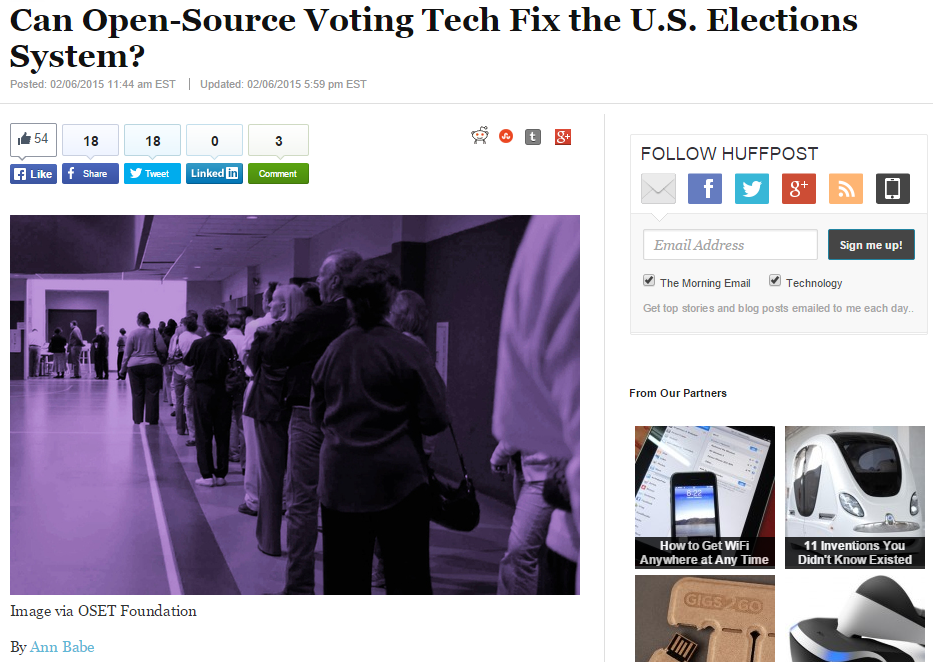CAVO Featured on The Huffington Post!
The California Association of Voting Officials (CAVO) was featured on The Huffington Post on February 6, 2015! As a corporate member of CAVO, Follow My Vote was excited to see the article and attention given to open-source technology. CAVO has been pushing for open-source solutions for voting which is one of the main reasons Follow My Vote was interested in a partnership. Former CAVO president Kammi Foote was quoted in the article and has campaigned for open-source technology and reduced cost for elections. While CAVO is based in California and has an initial focus in that area, they push for a higher standard of voting systems that can be used in the US and across the world. With both CAVO and Follow My Vote we can usher in a new era of open-source, low cost, and provably honest elections!
Other organizations like the California Association of Voting Officials (CAVO) are also working to bring open-source principles to American elections. “Every ballot that’s cast in the United States is counted by a machine, so we owe it to the voters and the public to use the most secure, most transparent, most auditable technology,” says former CAVO President Kammi Foote, who is also the elected registrar of voters for Inyo County, California. “Open source has proven itself in the private sector,” says Foote. “Now governments around the world are starting to look at open source as a good business model.”
The primitiveness of our voting technology is surprising in an era when we routinely use smartphones, big data is revolutionizing business, and the Internet of Things is spreading across the landscape. As Andrew Rasiej of the Personal Democracy Forum puts it, “Why haven’t we been able to apply an equal level of innovation in the way we vote?”
Time and again Americans are reminded of how inadequate our voting technology is. In 2000 it was the disastrous Florida recount, with its infamous “hanging chads.” In 2004 it was the Ohio recount. In 2008 a Minnesota recount. There were also problems in the 2012 Republican presidential primaries and the 2013 Virginia attorney-general race, not to mention innumerable, less-publicized local problems around the country.
One reason is that the U.S. elections-administration structure is decentralized and sprawling, delegating control to individual states and cities, which select and buy their own voting technology. Explains Foote, “Different jurisdictions use different technologies according to their budgets and timelines.” Sometimes they cobble together several kinds of technologies that only barely meet their needs. With about 180,000 precincts in the U.S., the outcome is a mishmash of machines, regulated by surprisingly few standards. While the 2002 Help America Vote Act appropriated billions of dollars to states to replace their punch-card- and lever-based voting machines with electronic ones, it didn’t do much to give them better electronic technology to choose from.
Because the voting-machine market is dominated by just three companies — Election System and Software, Dominion Voting Systems, and Hart InterCivic — elections administrators are left with very few options. Without any real competition and regulated by testing standards that are a decade old, incumbent voting-machine vendors have zero incentive to update their systems. According to Foote, “How can they invest in new technologies when they don’t know what future governments will allow?”
So elections administrators frequently buy outdated machines, use them for an election, and then store them away until the next one. As Miller puts it, “A voting machine spends most of its life in silence in cold, dark warehouses … only to be woken up periodically for one day of sheer chaos.” And as the machines grow older, the risk of problems also grows. “We’re still using 20-year-old technology that we know is problematic,” says Foote. If elections administrators could instead pool their resources together to develop free, open-source software, then run it on cheap, off-the-shelf hardware, they could ensure that every jurisdiction, no matter its budget, has the same access to the best voting technology available.
Read the rest of the article on The Huffington Post



